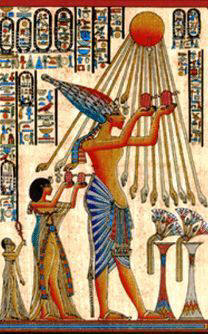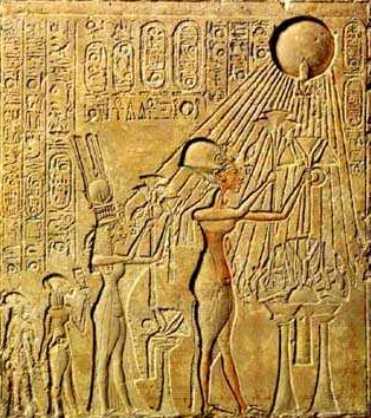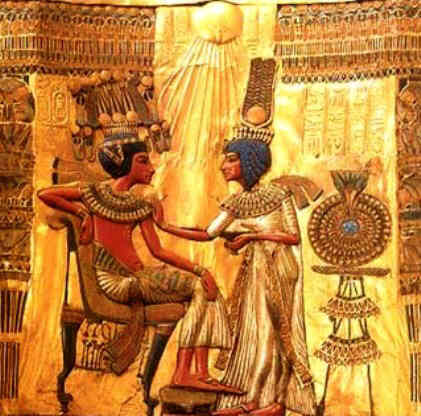
| Aten, god of Egypt | 
|
|
Ancient Egyptian Gods and Goddesses for kids - Aten The Mythology & History of ancient Egypt surrounding Aten, the sun god |
|
Aten, god of Egypt
Discover the legends and myths and religious beliefs surrounding Aten, the ancient Egyptian solar god who was originally an aspect of Atum-Ra or Ra, the Sun god. The god Aten was represented by the sun disk. The Aten was the focus of the monotheistic religion (the worship of one god) that was established by the Pharoah Amenhotep IV (the father of Tutankhamen). The Pharaoh changed his name to Akhenaten meaning 'pleasing to Aten' and caused massive turmoil and dissent in ancient Egypt and became known as the Heretic Pharaoh. The worship of Aten saw massive religious and spiritual changes in Ancient Egypt Akhenaten started a religious revolution but the priests of the old gods and many of the ancient Egyptians were totally against giving up their old gods in favor of Aten. |
|
Pictures and Images of the Aten
Aten was the Egyptian solar god. Unlike the old Egyptian gods and goddesses the images of the Aten did not take on a human or animal form. Aten was depicted as a a sun disk from which rays ended in hands extended hands. The sun disk was also depicted encircled buy and arc with a Uraeus rearing cobra symbol. Some of the hands were also depicted with the Ankh as a symbol of the power to give life or take it away. 
Facts about Aten
The following facts and profile provides a fast overview of the religion and worship of Aten:
Aten Profile & Fact File | | Egyptian Name: | Aten
| | Role & Function: | The function of Aten is described as being the god of the sun
| | Rise of the god: | Within four years of his reign, Akhenaten declared that all the old gods should be abandoned and replaced by one single god - the Aten
| | Status: | Aten, was established and worshipped as the single deity of Egypt.
| | Egyptian Religion: | The people of Egypt was forced to change from a polytheistic religion, the worship of many gods, to monotheism, meaning the worship of one god
| | Alternative Names: | Aton
| | Symbols: | The sun disk and the ankh
| | Title: | "The Ra-Horus who rejoices in the horizon, in his/her Name of the Light which is seen in the sun disc."
| | Cult center: | The new city of el Amarna (aka Akehetaten) was built which was located mid-way between Thebes and Memphis.
| | Worship of Aten: | Aten was worshipped for 16 years from 1349BC - 1333BC
| | Temples: | The Aten temples differed from the normal style of temples as they were open-roofed to allow the temples to be flooded with the rays of the sun
| | Statues: | There were no statues to the God Aten as these were viewed as idolatry
| | Priests: | Priests lost most of their power and concept of the Divine Kingship was further emphasised with Arkhenaten as the sole representative of Aten on earth.
| | Decline of Worship: | The worship of Aten died after the death of the Pharaoh Akhenaten. In 1331 BC there was a growing backlash against the new religion and the new, young pharaoh changed his name from Tutankhaten to Tutankhamun and the new city and cult center at Armana was abandoned.
|
|
|
The Worship of Aten
The following picture depicts the worship of the Aten by the Heretic Pharaoh Akhenaten, his wife Nefertiti and his son, Tutankhamen and his daughter, Ankhesenpaaten. 
| 
|
The worship of the Aten by the Heretic Pharaoh Akhenaten, his wife Nefertiti and his son, Tutankhamen
and his daughter, Ankhesenpaaten
| Nefertiti, the wife of Akhenaten,
the 'most beautiful woman in the world |
The above picture depicting the worship of Aten is interesting as it shows the changes caused by the religious revolution instigated by Akhenaten: - The image of Akhenaten is totally different from the ancient Egyptian art styles depicting all other gods. A complete divergence from the strict form and styles previously applied to Egyptian art
- The symbol of the sun disk has the Uraeus rearing cobra symbol attached, a potent emblem of sovereignty, royalty and divine authority in ancient Egypt
- The dominant, largest figure is Akhenaten wearing a cap crown, or royal cap, with the Uraeus. This style of head-dress enjoyed a revival in the Amarna period. His dominance reflects his autocratic style of kingship
- The wife of Akhenaten was Queen Nefertiti. Her prominence is highly unusual in ancient Egyptian history as she attained the power and status of a Pharaoh and co-ruler with Akhenaten. The priests and people were expected to revere both the Pharaoh and Nefertiti as gods on earth
- Akhenaten and Nefertiti are depicted offering Lotus flowers to Aten. The Lotus symbolized the sun, of creation, rebirth and regeneration. The Ancient Egyptians believed that scent had a divine origin and it was used in rituals, ceremonies related to the worship of the god
- The divine family take precedence with their god. Priests and Egyptians played a reduced role in the worship of the Aten. There were limited offerings, no processions and no oracles
|
|
Aten- Interesting research information and Facts about the Egyptian god Aton
- Aton, the Egyptian solar god
- Stories and Legends in Egyptian Mythology associated with Aton
- Facts and information about the gods and deities of of classical Egypt for schools, research and kids
- Aton, the Egyptian solar god
|
| | |
|
Facts about Aten in Egyptian Mythology
Discover interesting information and research facts about Aten, the Egyptian solar god. The facts about Aten provides a list detailing fascinating additional info to increase your knowledge about Aten in Egyptian Mythology. 
Akhenaten and Nefertiti bathed in the light of the Aten Mythology and Facts about the Aten | | Fact 1: | There was just one short period of monotheism (the worship of one god) when Akhenaten promoted the worship of the Aten and built a new city called Armana where the only god Aten would be worshipped
| | Fact 2: | The worship of the sun god Aten led to the belief that Aten was visible everywhere and was the fundamental life-giving force in the universe - not just a main god but the only god.
| | Fact 3: | The role of Aten was that of a benevolent god
| | Fact 4: | There is no direct Creation Myth relating to Aten, he was believed to have created everything. There was no family tree of gods
| | Fact 5: | During the reign of Akhenaten the worship of any other gods were and even temples were demolished. The cult of the god Amun was particularly targeted. Akhenaten ordered the statues of the old gods to be destroyed.
| | Fact 6: | Only Akhenaten knew the commandments of Aten. Akhenaten forced the population of Thebes, totalling over 20,000, to move to the new city of Amarna abandoning their businesses, homes and religion at Thebes.
| | Fact 7: | The god Aten remained distant and incomprehensible to the Ancient Egyptians
| | Fact 8: | As the sole, ruling god Aten received a royal title, inscribed like royal names in two oval cartouches
| | Fact 9: | One of the sanctuaries of Aten was called the Hwt-benben (meaning 'mansion of the Benben'). This emphasized the relationship between Aten and the Sun cult of Heliopolis and the ancient myth of the Benben stone.
| | Fact 10: | The Benben symbolized the primeval mound on which the sun god emerged from the primeval waters of Nun to create the universe
| | Fact 11: | The Cult of Amun revived soon after the death of Akhenaten and Amun became the national god of ancient Egypt.
|
|
|
|
|